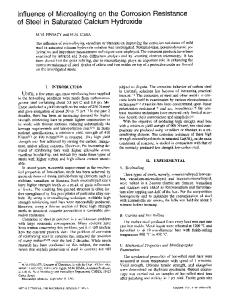Effect of Ti Microalloying on the Corrosion Behavior of Low-Carbon Steel in H 2 S/CO 2 Environment
- PDF / 5,668,688 Bytes
- 12 Pages / 593.972 x 792 pts Page_size
- 83 Downloads / 351 Views
JMEPEG https://doi.org/10.1007/s11665-020-05077-1
Effect of Ti Microalloying on the Corrosion Behavior of Low-Carbon Steel in H2S/CO2 Environment Chi Yu, Hongyan Wang, Xiuhua Gao, and Hongwei Wang (Submitted February 21, 2020; in revised form August 5, 2020) The corrosion behavior of two types of low-carbon steel (denoted steel A and steel B) in H2S/CO2 was investigated through immersion tests, and the effect of Ti microalloying on the corrosion mechanism was analyzed. The microstructures, corrosion kinetics, corrosion surface morphologies, corrosion phases, crosssectional morphologies and elemental distributions of the materials were studied by scanning electron microscopy (SEM), transmission electron microscopy (TEM), electron backscatter diffraction (EBSD), energy-dispersive spectroscopy (EDS), x-ray diffraction (XRD) and electron probe microanalysis (EPMA). The results showed that the corrosion rate of steel B with Ti microalloying was lower than that of steel A; the amount and formation rate of corrosion products in these two materials were different. As the immersion time increased, the corrosion products changed from iron-rich mackinawite to sulfur-rich pyrrhotite. In the early stage of corrosion, the corrosion products were primarily mackinawite, which controlled the corrosion phase through the entire process. After 384 h of immersion, pyrrhotite was observed, which can effectively protect the steel substrate, providing excellent corrosion resistance. The corrosion products in steel B with Ti microalloying were more compact than those in steel A. Moreover, Ti enrichment in the oxide film was observed in steel B, which can further improve its corrosion resistance. The results from this study can provide an important reference for the oil and gas industry. Keywords
corrosion behavior, H2S/CO2 low-carbon steel, Ti microalloying
environment,
1. Introduction Corrosion in pipeline steel, which is used in the oil and gas industry, has received substantial attention from scholars. In the presence of two acidic gases, H2S and CO2, pipeline steel will exhibit severe corrosion, which can cause accidents that result in large economic losses (Ref 1-3). Stainless steels have been used in oil and gas fields because they have better corrosion resistance than carbon steels (Ref 4-7). However, stainless steels are very expensive, which makes the overall process economically untenable; thus, low-carbon steels are typically used for pipeline applications because they are more costefficient. With the development of oil and gas fields, the corrosion of pipeline steels in H2S/CO2 environment has gradually become an intractable issue (Ref 8, 9). Corrosion behaviors are extremely complex in H2S/CO2 environment because the synergy of physical and chemical properties is unclear, and selecting appropriate materials is an arduous problem involving both economy and safety. Hence, it is
Chi Yu, State Key Laboratory of Rolling and Automation, Northeastern University, Shenyang 110819, China; and School of Resources and Materials, Northeas
Data Loading...











